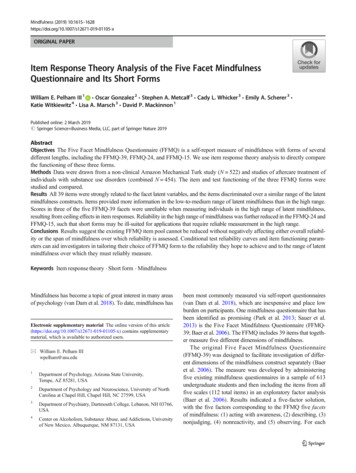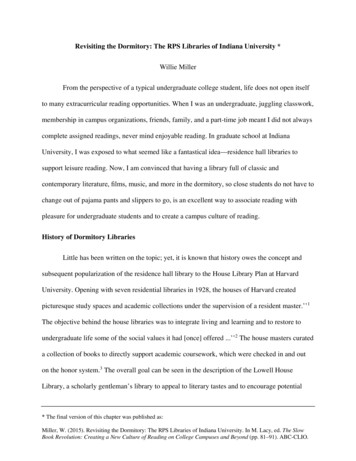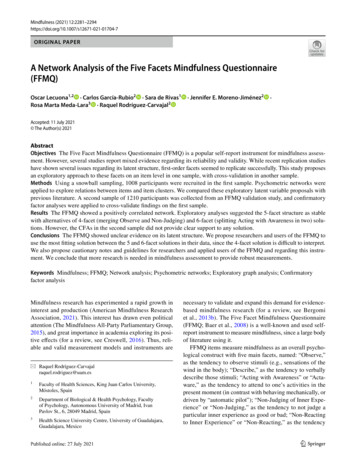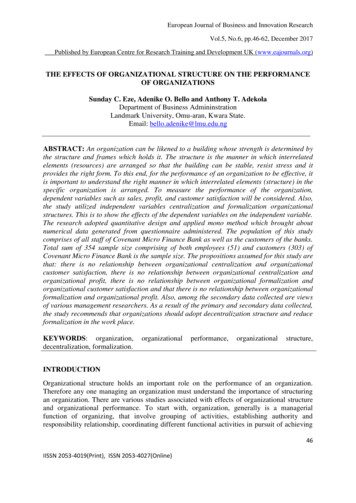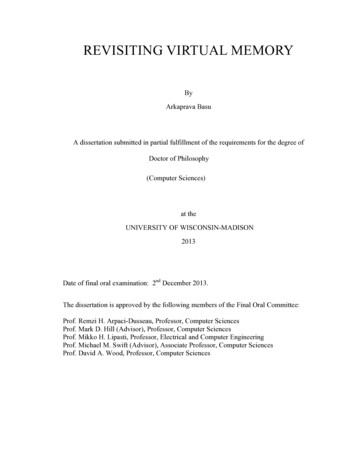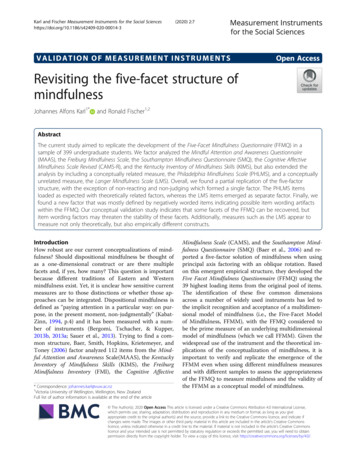
Transcription
Karl and Fischer Measurement Instruments for the Social (2020) 2:7VALIDATION OF MEASUREMENT INSTRUMENTSOpen AccessRevisiting the five-facet structure ofmindfulnessJohannes Alfons Karl1*and Ronald Fischer1,2AbstractThe current study aimed to replicate the development of the Five-Facet Mindfulness Questionnaire (FFMQ) in asample of 399 undergraduate students. We factor analyzed the Mindful Attention and Awareness Questionnaire(MAAS), the Freiburg Mindfulness Scale, the Southampton Mindfulness Questionnaire (SMQ), the Cognitive AffectiveMindfulness Scale Revised (CAMS-R), and the Kentucky Inventory of Mindfulness Skills (KIMS), but also extended theanalysis by including a conceptually related measure, the Philadelphia Mindfulness Scale (PHLMS), and a conceptuallyunrelated measure, the Langer Mindfulness Scale (LMS). Overall, we found a partial replication of the five-factorstructure, with the exception of non-reacting and non-judging which formed a single factor. The PHLMS itemsloaded as expected with theoretically related factors, whereas the LMS items emerged as separate factor. Finally, wefound a new factor that was mostly defined by negatively worded items indicating possible item wording artifactswithin the FFMQ. Our conceptual validation study indicates that some facets of the FFMQ can be recovered, butitem wording factors may threaten the stability of these facets. Additionally, measures such as the LMS appear tomeasure not only theoretically, but also empirically different constructs.IntroductionHow robust are our current conceptualizations of mindfulness? Should dispositional mindfulness be thought ofas a one-dimensional construct or are there multiplefacets and, if yes, how many? This question is importantbecause different traditions of Eastern and Westernmindfulness exist. Yet, it is unclear how sensitive currentmeasures are to those distinctions or whether those approaches can be integrated. Dispositional mindfulness isdefined as “paying attention in a particular way: on purpose, in the present moment, non-judgmentally” (KabatZinn, 1994, p.4) and it has been measured with a number of instruments (Bergomi, Tschacher, & Kupper,2013b, 2013a; Sauer et al., 2013). Trying to find a common structure, Baer, Smith, Hopkins, Krietemeyer, andToney (2006) factor analyzed 112 items from the Mindful Attention and Awareness Scale(MAAS), the KentuckyInventory of Mindfulness Skills (KIMS), the FreiburgMindfulness Inventory (FMI), the Cognitive Affective* Correspondence: johannes.karl@vuw.ac.nz1Victoria University of Wellington, Wellington, New ZealandFull list of author information is available at the end of the articleMindfulness Scale (CAMS), and the Southampton Mindfulness Questionnaire (SMQ) (Baer et al., 2006) and reported a five-factor solution of mindfulness when usingprincipal axis factoring with an oblique rotation. Basedon this emergent empirical structure, they developed theFive Facet Mindfulness Questionnaire (FFMQ) using the39 highest loading items from the original pool of items.The identification of these five common dimensionsacross a number of widely used instruments has led tothe implicit recognition and acceptance of a multidimensional model of mindfulness (i.e., the Five-Facet Modelof Mindfulness, FFMM), with the FFMQ considered tobe the prime measure of an underlying multidimensionalmodel of mindfulness (which we call FFMM). Given thewidespread use of the instrument and the theoretical implications of the conceptualization of mindfulness, it isimportant to verify and replicate the emergence of theFFMM even when using different mindfulness measuresand with different samples to assess the appropriatenessof the FFMQ to measure mindfulness and the validity ofthe FFMM as a conceptual model of mindfulness. The Author(s). 2020 Open Access This article is licensed under a Creative Commons Attribution 4.0 International License,which permits use, sharing, adaptation, distribution and reproduction in any medium or format, as long as you giveappropriate credit to the original author(s) and the source, provide a link to the Creative Commons licence, and indicate ifchanges were made. The images or other third party material in this article are included in the article's Creative Commonslicence, unless indicated otherwise in a credit line to the material. If material is not included in the article's Creative Commonslicence and your intended use is not permitted by statutory regulation or exceeds the permitted use, you will need to obtainpermission directly from the copyright holder. To view a copy of this licence, visit http://creativecommons.org/licenses/by/4.0/.
Karl and Fischer Measurement Instruments for the Social SciencesSince this seminal analysis by Baer et al. (2006), otherscales measuring dispositional mindfulness, such as thePhiladelphia Mindfulness Scale (Cardaciotto, Herbert,Forman, Moitra, & Farrow, 2008) and the Langer Mindfulness Scale (Pirson, Langer, Zilcha, & Zilcha, 2018),have been developed. These scales were not included inthe original analysis conducted by Baer et al. (2006), buta rigorous replication of the steps taken by Baer et al.(2006) including these scales may indicate the robustness of both the theoretical model of the FFMM and theempirical validity of the FFMQ. The aim of the currentstudy is to examine the comprehensiveness and robustness of the five-factor structure by examining whetherthe similar five facets emerge if the factor analysis is extended to those new measures.History of mindfulness assessmentTo provide some historical context, the source scales ofthe FFMQ were supposed to capture a number ofrelated but distinct dimensions, initially derived from anadaptation of Eastern philosophical thinking to Westernaudiences (Baer et al., 2006; Kucinskas, 2018). TheMAAS (Brown & Ryan, 2003) assesses the lack ofattention to one’s emotions, thoughts, sensations, andbehaviors in general and is proposed to measurepresent-awareness (Brown & Ryan, 2003; Carlson &Brown, 2005). The KIMS (Baer, Smith, & Allen, 2004)conceptualizes mindfulness as a four-dimensionalconstruct with acting with awareness, accept withoutjudgment, describing, and observing facets. The revisedFMI (Walach, Buchheld, Buttenmüller, Kleinknecht, &Schmidt, 2006) assesses a general factor of nonjudgmental present-moment awareness, therefore addingthe lack of self-evaluation as an important component ofthe construct. The CAMS-R (Feldman, Hayes, Kumar,Greeson, & Laurenceau, 2007) assesses four facets ofmindfulness: self-regulation of attention, orientation topresent-moment experience, awareness of experience,and accepting or non-judging attitude toward experience. The SMQ (Chadwick et al., 2008) assesses mindfulness in response to distressing images, focusing ondecentered awareness, staying open to difficult experience, non-judgmental acceptance, and seeing difficultcognitions as transient mental events without reacting tothem to measure a single score of mindfulness.Despite their differences, a factor analysis of these instruments using principal axis factoring with an obliquerotation based on all 112 items suggested that five mainfacets were sufficient to represent the data (Baer et al.,2006). Of the original set of 112 items, 64 items loadedsubstantially on one of the five facets. The observingfacet measures the awareness of internal experiences(emotions, cognitions) and external experiences (sounds,sights, and smells). The describing facet measures the(2020) 2:7Page 2 of 16tendency and ability to describe these internal and external experiences with words. The acting with awarenessfacet measures the tendency to bring full awareness andundivided focus to actions and experiences. The nonjudging facet measures the tendency to refrain fromevaluating inner experiences. The non-reactivity facetmeasures the tendency to accept emotions and states astransient and refrain from reacting to them. All thesefacets seem to capture elements that were central to theEastern philosophical foundations of mindfulness, exceptthat the spiritual and religious components have beenexcluded (Kabat-Zinn, 1994; Kucinskas, 2014).Mindfulness assessment since the development of theFFMQSince the development of the FFMQ, a number of additional measures have been proposed. One such novelmeasure is the Philadelphia Mindfulness Scale (PHLMS,Cardaciotto et al., 2008) which measures presentmoment awareness and acceptance as two related butempirically distinct concepts. These two dimensionsmaintain a Buddhist philosophical approach to mindfulness, and previous research has shown this measure tobe conceptually related to the FFMQ (Siegling & Petrides, 2016).Therefore, we expect that the PhiladelphiaMindfulness Scale (PHLMS) items will emerge jointlywith other related items and can be integrated in thefive-facet theoretical model .However, non-Buddhist measures of mindfulness havealso been proposed more recently, most notably theLanger Mindfulness Scale (LMS, Pirson et al., 2018). Pirson et al. (2012) defined mindfulness as “a mindset ofopenness to novelty in which the individual actively constructs novel categories and distinctions” (Pirson et al.,2012, p.3). This Western approach to mindfulness ismore focused on the socio-cognitive elements of mindfulness, highlighting that mindfulness is typically goaloriented and involves problem-solving and othercognitive exercises. Instead of the more meditativecontemplative aspect of Eastern mindfulness conceptualizations, it explicitly draws on the external, material, andsocial context of the individual. Their new measure issupposed to capture three-facets: novelty-production,novelty-seeking, and engagement. From our perspective,it is interesting to note that the philosophical orientationand the relevant motivational core of mindfulness aredifferent, but the constituent cognitive and attentionalelements might be similar. Not surprisingly, while theoretically and philosophically distinct, the LMS and theoverall score of the FFMQ have been found to correlatemoderately at r .33 to .37 (Pirson et al., 2018; Siegling& Petrides, 2014). This raises the question whether theseWestern-based mindfulness components can be integrated in the existing structure of the FFMQ. Given the
Karl and Fischer Measurement Instruments for the Social Sciencestheoretical philosophical background of this Westernmindfulness tradition, we expect the items of LMSwould emerge on distinct factor(s) in a joint factor analysis of mindfulness constructs. One of the interestingquestions is how distinct these Western-derived mindfulness dimensions are when analyzed together withinstruments that have been inspired by Easternphilosophy.Current researchIn summary, the FFMQ has emerged as the primemeasure to capture the FFMM (Baer et al., 2006). TheFFMQ has been derived in a bottom-up approach byfactor analyzing pre-existing measures (Baer et al.,2006). This empirically driven approach requires confirmation and replication to assess the theoretical appropriateness of the FFMQ as the principal measure ofa multidimensional mindfulness construct (Magnusson,1992; Tellis, 2017). While previous studies haveemployed a confirmatory strategy using only the finalFFMQ (Gu et al., 2016; Williams, Dalgleish, Karl, &Kuyken, 2014), no study to date has undertaken a conceptual replication of the generation of the underlyingFFMM. One reason this is important is to examine thepotential presence of item wording effects in thecurrent measurement of mindfulness (for studiesreporting such method factors in the FFMQ see:Aguado et al., 2015; Van Dam, Hobkirk, Danoff-Burg,& Earleywine, 2012). Further, these studies have shownthat a bi-factor model of the FFMQ, in which all itemsload onto a general factor of mindfulness and their individual facets while including wording factors, substantially improved the structure. This indicates thatbeyond their assignment to individual facets mindfulness items might share some common variance thatcould be explained by a general factor (for a discussionof this interpretation of a bi-factor model see: Bonifay,Lane, & Reise, 2017). In the FFMQ, this factor couldrepresent Buddhist-inspired mindfulness raising thequestion if a similar bi-factor model emerges whenWestern-oriented measures of mindfulness are included. Investigating the emergent structure of themindfulness measures is also of interest because bothnovel Buddhist inspired as well as Western-orientedmeasures of mindfulness have been developed since thepublication of the FFMQ, raising important questionsboth about the comprehensiveness of the FFMM andthe appropriateness of the FFMQ to measure such amultidimensional model of mindfulness. The currentstudy aims to extend the current research on the dimensionality of mindfulness by re-examining the emergence of multi-dimensional mindfulness structuresincluding recent measures of mindfulness.(2020) 2:7Page 3 of 16MethodsParticipantsWe sampled 404 undergraduate students at VictoriaUniversity of Wellington. Five participants (1.24% ofthe total) started the questionnaire but did not finishit. Due to the low number of participants that didnot answer the survey completely, we removed thosefive individuals from the dataset, leaving an effectivesample size of 399. The average age of the participants was 19.21(SD 3.93), and 68.92% of the totalsample were female.Previous mindfulness practice Of the total sample,8.77% reported previous mindfulness experience, 9.52%reported yoga experience, and 10.03% reported meditation experience. This sample composition in terms ofage and mindfulness experience is comparable to theoriginal FFMQ study (Baer et al., 2006). Due to the lownumber of participants with previous meditation experience, we did not perform separate analysis comparingmeditation practitioners and participants with no meditation experience.Procedure Participants filled out an online survey onQualtrics (the Qualtrics survey file and a word version of the survey are available on the OSF: https://osf.io/k2m35/). The mindfulness scales were presentedas part of a larger survey pack. The survey pack alsocontained measures of personality (Soto & John,2017), reinforcement sensitivity (Corr & Cooper,2016), values (Schwartz et al., 2012), impression management (Blasberg, Rogers, & Paulhus, 2014), selfdeception (Paulhus & Reid, 1991), satisfaction withlife (Diener, Emmons, Larsen, & Griffin, 1985), flourishing (Diener et al., 2010), and a number of behavioral tasks (pen choices) to assess group conformity.The complete data are available on the OSF. Individuals participated as part of an Introduction to Psychology course and received course credit.Open science statementThe current study reports an exploratory analysis intothe structure of mindfulness. Recent studies (e.g., Silberzahn et al., 2018) demonstrate the impact of analytic freedom on reported outcomes. We aim toprovide maximum transparency of the analysis byproviding the full raw data set, the analytic code, andall materials associated with the study on the OpenScience Framework (https://osf.io/k2m35/). Thecurrent study was part of a larger pack of surveys administered to the participants.
Karl and Fischer Measurement Instruments for the Social SciencesInstrumentsThe Mindful Attention and Awareness Scale TheMAAS (Brown & Ryan, 2003) uses 15 items that a participant rates on a scale from 1 (almost always) to 6 (almost never). Example items are “I do jobs or tasksautomatically, without being aware of what I’m doing.”and “I find myself listening to someone with one ear,doing something else at the same time.” Lower scores onthese items indicate greater mindfulness.The Southampton Mindfulness Questionnaire Weused the 16-item SMQ (Chadwick et al., 2008), with a 7point Likert scale ranging from 1 (strongly disagree) to 7(strongly agree). The questionnaire was preceded by thestatement: “Usually when I experience distressingthoughts and images.” Example items are “I am ablejust to notice them without reacting.” and “They takeover my mind for quite a while afterwards.”The Cognitive and Affective Mindfulness ScaleRevised The Cognitive and Affective Mindfulness ScaleRevised (CAMS-R) is a 12-item measure with four subcomponents (Feldman et al., 2007). Participants answered the items on a 4-point Likert scale ranging from1 (rarely/not at all) to 4 (almost always). Example itemsfor the individual subcomponents are “It is easy for meto concentrate on what I am doing.” (attention), “I amable to focus on the present moment.” (present focus),“It’s easy for me to keep track of my thoughts and feelings.” (awareness), “I can tolerate emotional pain.”(acceptance).The Freiburg Mindfulness Inventory We used the 14item FMI (Walach et al., 2006) with the original 4-pointLikert scale ranging from 1 (rarely) to 4 (almost always).Example items are “I am open to the experience of thepresent moment.” and “I sense my body, whether eating,cooking, cleaning or talking.” In their original study Baeret al. (2006) used an earlier developmental version of theFMI which had 30 items.Kentucky Inventory of Mindfulness Skills We usedthe 39-item KMI to assess a multi-dimensionalconceptualization of mindfulness (Baer et al., 2004). Theitems are rated on a 5-point Likert scale ranging from 1(never or very rarely true) to 5 (very often or alwaystrue). Example items are “I’m good at finding the wordsto describe my feelings.” (describing); “I notice changesin my body, such as whether my breathing slows downor speeds up.” (observing); “When I do things, my mindwanders off and I’m easily distracted.” (acting withawareness); “I criticize myself for having irrational or inappropriate emotions.” (non-judging).(2020) 2:7Page 4 of 16The Langer Mindfulness Scale We used the 14-itemLMS (Pirson et al., 2018) to assess a multi-dimensionalconceptualization of socio-cognitive mindfulness. Theitems are rated on a 7-point Likert scale ranging from 1(strongly disagree) to 7 (strongly agree). Example itemsare “I am rarely alert to new developments.” (engagement); “I make many novel contributions.” (novelty producing); “I like to investigate things.” (novelty seeking).We report the reliabilities and scale descriptives of allmeasures in Table 1. We decided to evaluate reliabilityusing ω, the greatest lower bound (GLB), and coefficientH (H). These indicators have been shown in previous research to provide better estimations of reliability compared to α (McNeish, 2018; Trizano-Hermosilla &Alvarado, 2016). We nevertheless report α for comparison purposes. Both α and ω are reported with bootstrapped 95% confidence intervals. All reliabilitycoefficients were obtained using the userfriendlysciencepackage (version 0.7.2) in R (Peters, 2018). The reliabilities were acceptable (values above .7), except for LMSengagement, CAMS awareness, CAMS acceptance, andCAMS present focus.Analytical approachWe first examined the theoretically proposed fit for eachmindfulness scale using separate CFAs. This analysisprovides important information on the internal validityof each of these measures and therefore, offers important background information for understanding the replication study. For each scale, we fitted the structureswhich were proposed by the original authors of the measures. Specifically, we fitted a uni-dimensional model forthe FMI, the SMQ, and the MAAS, respectively. For thePHLMS, we fitted a model with two correlated firstorder factors (acceptance, awareness). For the LMS, wefitted a model with three correlated first-order factors(novelty producing, novelty seeking, engagement). Forthe KIMS, we fitted a model with four first-order factors(observing, describing, non-judging, and acting withawareness) and a second-order factor representingmindfulness. For the CAMS-R, we fitted a model withfour first-order factors (attention, present focus, awareness, and acceptance) and a second-order factor representing overall mindfulness. Therefore, we have anumber of single factor models (FMI, SMQ, MAAS); atwo-factor model (PHLMS); a three-factor model (LMS);and two four-factor models with a second-order mindfulness factor (CAMS-R, KIMS).Due to multivariate non-normality of our data, allmodels were fitted using an WLSMV estimator ratherthan parceling items (Li, 2016; Maydeu-Olivares, 2017).We use the following fit indices: A χ2/degrees of freedom ratio of 5 is considered acceptable (Wheaton,Muthen, Alwin, & Summers, 1977), CFI and γ (with .90
Karl and Fischer Measurement Instruments for the Social Sciences(2020) 2:7Page 5 of 16Table 1 Reliability and scale descriptives of the mindfulness measuresMSDαα lowα highωω lowω highGLBHCAMS-R AMS-R present R AMS-R Freiburg Mindfulness anger Mindfulness Scale Langer Mindfulness Scale novelty anger Mindfulness Scale novelty hia Mindfulness Scale hiladelphia Mindfulness Scale Southampton Mindfulness 878Kentucky Mindfulness Inventory entucky Mindfulness Inventory Kentucky Mindfulness Inventory acting with entucky Mindfulness Inventory 2Notes: α and ω are reported with 95% bias corrected confidence intervalsGLB greatest lower bound, H coefficient Hdefined as threshold for acceptable fit and .95 defined asthreshold for good fit, Marsh, Hau, & Wen, 2004),RMSEA (with less than 0.01, 0.05, and 0.08 to indicateexcellent, good, and mediocre fit respectively, MacCallum, Browne, & Sugawara, 1996), and SRMR (acceptablefit is indicated by values less than .08, Hu & Bentler,1999). We further report χ2 and degrees of freedom foreach model, but do not focus on these indicators due tothe known dependency on sample size.Second, we ran an exploratory factor analysis using allmindfulness items to investigate the structure across allitems and all instruments. We started off with a parallelanalysis using the complete pool of items from the allmindfulness scales to determine the optimal number ofcomponents while accounting for components occurringdue to random chance. We used Glorfeld’s (1995) conservative approach instead of Horn’s (1965) parallel analysis. We retained components which had eigenvaluesgreater than one after adjusting the initial eigenvaluesfor the eigenvalues observed in a random data set.To examine the unfolding of the factor structure (seeGoldberg, 2006), we implemented an iterative process inwhich we ran a PCA with 1 up to the number of factorsproposed by the parallel analysis. After extracting eachset of components using a principal component analysiswith a varimax rotation using the psych package (version1.8.12) in R (Revelle, 2018), we correlated participants’scores on these components with the previously extracted component (Goldberg, 2006). This approachprovides insight into the pattern of emergence ofcomponents (for examples see: De Raad et al., 2014; DeRaad & Van Oudenhoven, 2008, 2011) .ResultsConfirmatory factor analysisThe CFA of the individual scales showed acceptable fitfor the FMI, the MAAS, and the CAMS-R. Interestingly,the CAMS-R showed good fit while its individual scaleshad poor reliability. The other measures showed lessthan acceptable overall fit (see Table 2). Compared toprevious studies using these measures, we found that inour sample the FMI and CAMS-R showed better fit,whereas the PHLMS, KIMS, SMQ, and LMS showedworse fit compared to other studies (we include a tablereporting fit statistics from previous studies which weused to compare our results against on the OSF).Factorial structureThe parallel analysis suggested 6 components (adjustedeigenvalues 15.61, 8.27, 2.39, 1.55, 1.37, 1.27). We therefore extracted 1 to 6 components based on the parallelanalysis explaining 34% of the total variance. For the 6component structure, we report the highest negative andpositive loading items for each component in Table 3 toallow for easier interpretation. Additionally, the fullloading matrix for the 6-component solution can befound in Table 4. We only interpreted loadings .40when examining the loading matrices of the items. Noitems were deleted. Due to space constraints, we madethe full rotated component matrices for all solutions
Karl and Fischer Measurement Instruments for the Social Sciences(2020) 2:7Page 6 of 16Table 2 CFA fit of the individual mindfulness measuresMeasureχ2dfχ2/dfCFIRMSEAGammaOverall fitFreiburg Mindfulness Inventory168.288772.186.922.055.968GoodLanger Mindfulness 4.944.043.978GoodPhiladelphia Mindfulness Scale379.2461692.244.884.056.95PoorSouthampton Mindfulness ky Mindfulness .752502.595.909.063.968GoodNotes: all models were fitted with a WLSMV estimator. Overall fit is assessed as good if CFI .90, RMSEA .80, and SRMR .08Table 3 Components extracted with their highest positive and negative loading itemsComponent NamePositiveNegative1 1Non-judgmentalawarenessI am able to accept the thoughts and feelings I have.I think some of my emotions are bad or inappropriate and Ishouldn’t feel them.2 1Judgmental nonawarenessI tell myself that I shouldn’t be feeling the way I’m feeling.I am able to accept the thoughts and feelings I have.2 2ObservingI intentionally stay aware of my feelings.I am not an original thinker.3 1Non-judgmentI am friendly to myself when things go wrong.I think some of my emotions are bad or inappropriate and Ishouldn’t feel them.3 2ObservingWhen talking with other people, I am aware of the emotions Iam experiencing.I am not an original thinker.3 3Describing/focusWhen someone asks how I am feeling, I can identify myemotions easily.It’s hard for me to find the words to describe what I’m thinking.4 1Non-judgmentI am friendly to myself when things go wrong.Usually when I experience distressing thoughts and images. I getangry that this happens to me.4 2ObservingWhen I walk outside, I am aware of smells or how the air feelsagainst my face.I am rarely aware of changes.4 3Self-criticismI tell myself that I shouldn’t be feeling the way I’m feeling.It seems I am “running on automatic” without much awareness ofwhat I’m doing.4 4Describing/opennessI’m good at finding the words to describe my feelings.It’s hard for me to find the words to describe what I’m thinking.5 1Non-judgmentI am friendly to myself when things go wrong.Usually when I experience distressing thoughts and images. I getangry that this happens to me.5 2ObservingWhen I walk outside, I am aware of smells or how the air feelsagainst my face.I am rarely aware of changes.5 5Self-criticismI tell myself that I shouldn’t have certain thoughts.I accept myself the same whatever the thought/image is about inmy mind.5 3Acting withawarenessI find myself doing things without paying attention.When I do things, my mind wanders off and I’m easily distracted.5 4DescribingI’m good at finding the words to describe my feelings.It’s hard for me to find the words to describe what I’m thinking.6 1Non-judgment/nonreactingI am friendly to myself when things go wrong.I wish I could control my emotions more easily.6 2ObservingWhen I walk outside, I am aware of smells or how the air feelsagainst my face.I am rarely aware of changes.6 3Acting withawarenessI find myself doing things without paying attention.When I do things, my mind wanders off and I’m easily distracted.6 5Reacting-judgmentIf there is something I don’t want to think about, I’ll try manythings to get it out of my mind.I accept myself the same whatever the thought/image is about inmy mind.6 6DescribingI’m good at finding the words to describe my feelings.It’s hard for me to find the words to describe what I’m thinking.6 4Openness/WesternmindfulnessI like to be challenged intellectually.I am not an original thinker.
Karl and Fischer Measurement Instruments for the Social Sciences(2020) 2:7Page 7 of 16Table 4 Component loadings of the mindfulness items on the final six componentsC1C5C2C3C6C4ItemMeasure.61 .14.09.12.03.06I am friendly to myself when things go wrong.FRBRG.61 .12.17.12.06.04I am able to appreciate myself.FRBRG.60 .21 .06 .02.19 .01I feel calm soon after.SMQ.58 .23.04.06.08.11I am able to accept the experience.SMQ.56 .14 .15.03.07.04I just notice them and let them go.SMQ.55 .04.06.05 .08 .04I see my mistakes and difficulties without judging them.FRBRG.54 .24.06 .01.16.05I “step back” and am aware of the thought or image without getting taken over by it.SMQ.53 .03 .08.11.07.16I watch my feelings without getting lost in them.FRBRG.52 .29.17.15.21.09I am able to accept the thoughts and feelings I have.CAMS.51 .30.09.09.09 .04I accept myself the same whatever the thought/image is about in my mind.SMQ.51.11.18.10 .02.11I am open to the experience of the present moment.FRBRG.49 .08.02 .01.12 .07I try just to experience the thoughts or images without judging them.SMQ.49.07.15.29.16.08I am able to focus on the present moment.CAMS.49.14.17.20.13.09I feel connected to my experience in the here-and-now.FRBRG.49 .04.11.12.12.08I experience moments of inner peace and ease, even when things get hectic and stressful.FRBRG.48 .15.25.03.09 .04I try to notice my thoughts without judging them.CAMS.47.00.09.04 .06
Mindfulness Scale (CAMS), and the Southampton Mind-fulness Questionnaire (SMQ) (Baer et al., 2006) and re-ported a five-factor solution of mindfulness when using principal axis factoring with an oblique rotation. Based on this emergent empirical structure, they developed the Five Facet Mindfulness Questionnaire (FFMQ) using the


